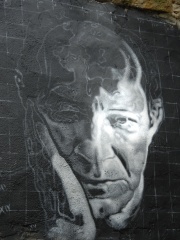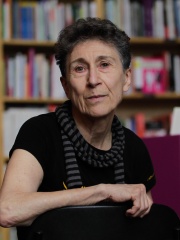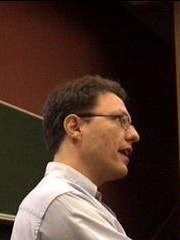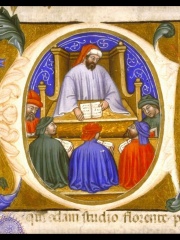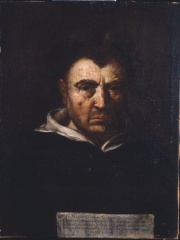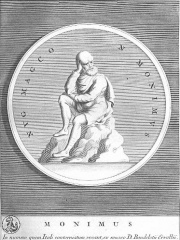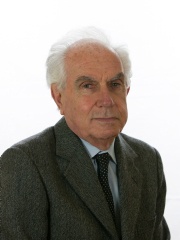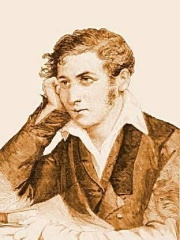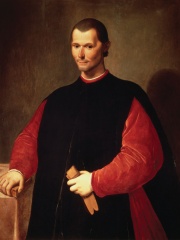
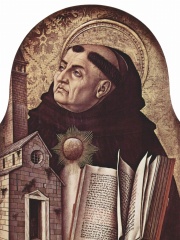
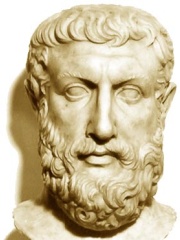
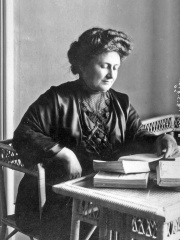
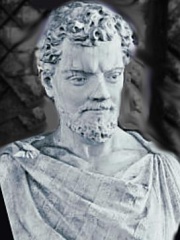
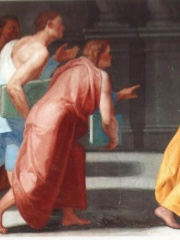

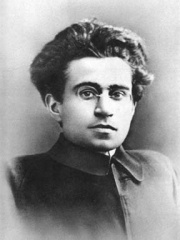
The Most Famous
PHILOSOPHERS from Italy
This page contains a list of the greatest Italian Philosophers. The pantheon dataset contains 1,267 Philosophers, 72 of which were born in Italy. This makes Italy the birth place of the 5th most number of Philosophers behind United Kingdom, and United States.
Top 10
The following people are considered by Pantheon to be the top 10 most legendary Italian Philosophers of all time. This list of famous Italian Philosophers is sorted by HPI (Historical Popularity Index), a metric that aggregates information on a biography’s online popularity. Visit the rankings page to view the entire list of Italian Philosophers.

1. Niccolò Machiavelli (1469 - 1527)
With an HPI of 87.23, Niccolò Machiavelli is the most famous Italian Philosopher. His biography has been translated into 142 different languages on wikipedia.
Niccolò di Bernardo dei Machiavelli (3 May 1469 – 21 June 1527) was a Florentine diplomat, author, philosopher and historian who lived during the Renaissance. He is best known for his political treatise The Prince (Il Principe), written around 1513 but not published until 1532, five years after his death. He has often been called the father of modern political philosophy and political science.For many years he served as a senior official in the Florentine Republic with responsibilities in diplomatic and military affairs. He wrote comedies, carnival songs, and poetry. His personal correspondence is also important to historians and scholars of Italian correspondence. He worked as secretary to the second chancery of the Republic of Florence from 1498 to 1512, when the Medici were out of power. After his death Machiavelli's name came to evoke unscrupulous acts of the sort he advised most famously in his work, The Prince. He claimed that his experience and reading of history showed him that politics have always been played with deception, treachery, and crime. He also notably said that a ruler who is establishing a kingdom or a republic, and is criticized for his deeds, including violence, should be excused when the intention and the result are beneficial to him. Machiavelli's Prince has been surrounded by controversy since it was published. Some consider it to be a straightforward description of political reality. Others view The Prince as a manual, teaching would-be tyrants how they should seize and maintain power. Even into recent times, some scholars, such as Leo Strauss, have restated the traditional opinion that Machiavelli was a "teacher of evil".Even though Machiavelli has become most famous for his work on principalities, scholars also give attention to the exhortations in his other works of political philosophy. While less well known than The Prince, the Discourses on Livy (composed c. 1517) has been said to have paved the way for modern republicanism. His works were a major influence on Enlightenment authors who revived interest in classical republicanism, such as Jean-Jacques Rousseau and James Harrington. Machiavelli's political realism has continued to influence generations of academics and politicians, including Hannah Arendt and Otto von Bismarck.

2. Thomas Aquinas (1225 - 1274)
With an HPI of 85.68, Thomas Aquinas is the 2nd most famous Italian Philosopher. His biography has been translated into 149 different languages.
Thomas Aquinas (, ə-KWY-nəs; Italian: Tommaso d'Aquino, lit. 'Thomas of Aquino'; c. 1225 – 7 March 1274) was an Italian Dominican friar and priest, an influential philosopher and theologian, and a jurist in the tradition of scholasticism from the county of Aquino in the Kingdom of Sicily. Thomas was a prominent proponent of natural theology and the father of a school of thought (encompassing both theology and philosophy) known as Thomism. He argued that God is the source of the light of natural reason and the light of faith. He embraced several ideas put forward by Aristotle and attempted to synthesize Aristotelian philosophy with the principles of Christianity. He has been described as "the most influential thinker of the medieval period" and "the greatest of the medieval philosopher-theologians". According to the English philosopher Anthony Kenny, Thomas was "one of the greatest philosophers of the Western world".Thomas's best-known works are the unfinished Summa Theologica, or Summa Theologiae (1265–1274), the Disputed Questions on Truth (1256–1259) and the Summa contra Gentiles (1259–1265). His commentaries on Christian Scripture and on Aristotle also form an important part of his body of work. He is also notable for his Eucharistic hymns, which form a part of the Church's liturgy.As a Doctor of the Church, Thomas Aquinas is considered one of the Catholic Church's greatest theologians and philosophers. He is known in Catholic theology as the Doctor Angelicus ("Angelic Doctor", with the title "doctor" meaning "teacher"), and the Doctor Communis ("Universal Doctor"). In 1999, John Paul II added a new title to these traditional ones: Doctor Humanitatis ("Doctor of Humanity/Humaneness").

3. Parmenides (-501 - -470)
With an HPI of 81.40, Parmenides is the 3rd most famous Italian Philosopher. His biography has been translated into 86 different languages.
Parmenides of Elea (; Greek: Παρμενίδης ὁ Ἐλεάτης; fl. late sixth or early fifth century BC) was a pre-Socratic Greek philosopher from Elea in Magna Graecia. Parmenides was born in the Greek colony of Elea, from a wealthy and illustrious family. His dates are uncertain; according to doxographer Diogenes Laërtius, he flourished just before 500 BC, which would put his year of birth near 540 BC, but in the dialogue Parmenides Plato has him visiting Athens at the age of 65, when Socrates was a young man, c. 450 BC, which, if true, suggests a year of birth of c. 515 BC. He is thought to have been in his prime (or "floruit") around 475 BC.The single known work by Parmenides is a poem whose original title is unknown but which is often referred to as On Nature. Only fragments of it survive. In his poem, Parmenides prescribes two views of reality. The first, the Way of "Aletheia" or truth, describes how all reality is one, change is impossible, and existence is timeless and uniform. The second view, the way of "Doxa", or opinion, describes the world of appearances, in which one's sensory faculties lead to conceptions which are false and deceitful. Parmenides has been considered the founder of ontology and has, through his influence on Plato, influenced the whole history of Western philosophy. He is also considered to be the founder of the Eleatic school of philosophy, which also included Zeno of Elea and Melissus of Samos. Zeno's paradoxes of motion were developed to defend Parmenides' views. In contemporary philosophy, Parmenides' work has remained relevant in debates about the philosophy of time.

4. Maria Montessori (1870 - 1952)
With an HPI of 80.95, Maria Montessori is the 4th most famous Italian Philosopher. Her biography has been translated into 90 different languages.
Maria Tecla Artemisia Montessori ( MON-tiss-OR-ee, Italian: [maˈriːa montesˈsɔːri]; 31 August 1870 – 6 May 1952) was an Italian physician and educator best known for her philosophy of education and her writing on scientific pedagogy. At an early age, Montessori enrolled in classes at an all-boys technical school, with hopes of becoming an engineer. She soon had a change of heart and began medical school at the Sapienza University of Rome, becoming one of the first women to attend medical school in Italy; she graduated with honors in 1896. Her educational method is in use today in many public and private schools globally.
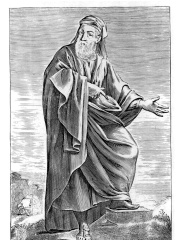
5. Empedocles (-490 - -430)
With an HPI of 79.81, Empedocles is the 5th most famous Italian Philosopher. His biography has been translated into 82 different languages.
Empedocles (; Greek: Ἐμπεδοκλῆς; c. 494 – c. 434 BC, fl. 444–443 BC) was a Greek pre-Socratic philosopher and a native citizen of Akragas, a Greek city in Sicily. Empedocles' philosophy is best known for originating the cosmogonic theory of the four classical elements. He also proposed forces he called Love and Strife which would mix and separate the elements, respectively. Empedocles challenged the practice of animal sacrifice and killing animals for food. He developed a distinctive doctrine of reincarnation. He is generally considered the last Greek philosopher to have recorded his ideas in verse. Some of his work survives, more than is the case for any other pre-Socratic philosopher. Empedocles' death was mythologized by ancient writers, and has been the subject of a number of literary treatments.

6. Lucretius (-94 - -55)
With an HPI of 79.25, Lucretius is the 6th most famous Italian Philosopher. His biography has been translated into 80 different languages.
Titus Lucretius Carus ( TY-təs loo-KREE-shəs, Latin: [ˈtitus luˈkreːti.us ˈkaːrus]; c. 99 – c. 55 BC) was a Roman poet and philosopher. His only known work is the philosophical poem De rerum natura, a didactic work about the tenets and philosophy of Epicureanism, which usually is translated into English as On the Nature of Things—and somewhat less often as On the Nature of the Universe. Very little is known about Lucretius's life; the only certainty is that he was either a friend or client of Gaius Memmius, to whom the poem was addressed and dedicated. De rerum natura was a considerable influence on the Augustan poets, particularly Virgil (in his Aeneid and Georgics, and to a lesser extent on the Eclogues) and Horace. The work was almost lost during the Middle Ages, but was rediscovered in 1417 in a monastery in Germany by Poggio Bracciolini and it played an important role both in the development of atomism (Lucretius was an important influence on Pierre Gassendi) and the efforts of various figures of the Enlightenment era to construct a new Christian humanism.

7. Zeno of Elea (-490 - -425)
With an HPI of 78.17, Zeno of Elea is the 7th most famous Italian Philosopher. His biography has been translated into 78 different languages.
Zeno of Elea (; Ancient Greek: Ζήνων ὁ Ἐλεᾱ́της; c. 490 – c. 430 BC) was a pre-Socratic Greek philosopher. He was a student of Parmenides and one of the Eleatics. Born in Elea, Zeno defended his instructor's belief in monism, the idea that only one single entity exists that makes up all of reality. He rejected the existence of space, time, and motion. To disprove these concepts, he developed a series of paradoxes to demonstrate why these are impossible. Though his original writings are lost, subsequent descriptions by Plato, Aristotle, Diogenes Laertius, and Simplicius of Cilicia have allowed study of his ideas. Zeno's arguments are divided into two different types: his arguments against plurality, or the existence of multiple objects, and his arguments against motion. Those against plurality suggest that for anything to exist, it must be divisible infinitely, meaning it would necessarily have both infinite mass and no mass simultaneously. Those against motion invoke the idea that distance must be divisible infinitely, meaning infinite steps would be required to cross any distance. Zeno's philosophy is still debated in the present day, and no solution to his paradoxes has been agreed upon by philosophers. His paradoxes have influenced philosophy and mathematics, both in ancient and modern times. Many of his ideas have been challenged by modern developments in physics and mathematics, such as atomic theory, mathematical limits, and set theory.

8. Pliny the Elder (23 - 79)
With an HPI of 76.88, Pliny the Elder is the 8th most famous Italian Philosopher. His biography has been translated into 89 different languages.
Gaius Plinius Secundus (AD 23/24 – AD 79), called Pliny the Elder (), was a Roman author, naturalist, natural philosopher, naval and army commander of the early Roman Empire, and a friend of the emperor Vespasian. He wrote the encyclopedic Naturalis Historia (Natural History), which became an editorial model for encyclopedias. He spent most of his spare time studying, writing, and investigating natural and geographic phenomena in the field. Among Pliny's greatest works was the twenty-volume Bella Germaniae ("The History of the German Wars"), which is no longer extant. Bella Germaniae, which began where Aufidius Bassus' Libri Belli Germanici ("The War with the Germans") left off, was used as a source by other prominent Roman historians, including Plutarch, Tacitus, and Suetonius. Tacitus may have used Bella Germaniae as the primary source for his work, De origine et situ Germanorum ("On the Origin and Situation of the Germans").Pliny the Elder died in AD 79 in Stabiae while attempting the rescue of a friend and his family from the eruption of Mount Vesuvius.

9. Antonio Gramsci (1891 - 1937)
With an HPI of 76.69, Antonio Gramsci is the 9th most famous Italian Philosopher. His biography has been translated into 91 different languages.
Antonio Francesco Gramsci (UK: GRAM-shee, US: GRAHM-shee, Italian: [anˈtɔːnjo franˈtʃesko ˈɡramʃi] ; 22 January 1891 – 27 April 1937) was an Italian Marxist philosopher, linguist, journalist, writer, and politician. He wrote on philosophy, political theory, sociology, history, and linguistics. He was a founding member and one-time leader of the Italian Communist Party. A vocal critic of Benito Mussolini and fascism, he was imprisoned in 1926 where he remained until his death in 1937. During his imprisonment, Gramsci wrote more than 30 notebooks and 3,000 pages of history and analysis. His Prison Notebooks are considered a highly original contribution to 20th-century political theory. Gramsci drew insights from varying sources — not only other Marxists but also thinkers such as Niccolò Machiavelli, Vilfredo Pareto, Georges Sorel, and Benedetto Croce. The notebooks cover a wide range of topics, including the history of Italy and Italian nationalism, the French Revolution, fascism, Taylorism and Fordism, civil society, the state, historical materialism, folklore, religion, and high and popular culture. Gramsci is best known for his theory of cultural hegemony, which describes how the state and ruling capitalist class — the bourgeoisie — use cultural institutions to maintain power in capitalist societies. In Gramsci's view, the bourgeoisie develops a hegemonic culture using ideology rather than violence, economic force, or coercion. He also attempted to break from the economic determinism of orthodox Marxist thought, and so is sometimes described as a neo-Marxist. He held a humanistic understanding of Marxism, seeing it as a philosophy of praxis and an absolute historicism that transcends traditional materialism and traditional idealism.
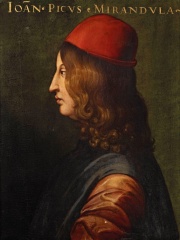
10. Giovanni Pico della Mirandola (1463 - 1494)
With an HPI of 74.94, Giovanni Pico della Mirandola is the 10th most famous Italian Philosopher. His biography has been translated into 57 different languages.
Giovanni Pico dei conti della Mirandola e della Concordia ( PEE-koh DEL-ə mirr-A(H)N-də-lə, Italian: [dʒoˈvanni ˈpiːko della miˈrandola]; Latin: Johannes Picus de Mirandula; 24 February 1463 – 17 November 1494), known as Pico della Mirandola, was an Italian Renaissance nobleman and philosopher. He is famed for the events of 1486, when, at the age of 23, he proposed to defend 900 theses on religion, philosophy, natural philosophy, and magic against all comers, for which he wrote the Oration on the Dignity of Man, which has been called the "Manifesto of the Renaissance", and a key text of Renaissance humanism and of what has been called the "Hermetic Reformation". He was the founder of the tradition of Christian Kabbalah, a key tenet of early modern Western esotericism. The 900 Theses was the first printed book to be universally banned by the Church. Pico is sometimes seen as a proto-Protestant, because his 900 theses anticipated many Protestant views.
People
Pantheon has 77 people classified as Italian philosophers born between 600 BC and 1965. Of these 77, 5 (6.49%) of them are still alive today. The most famous living Italian philosophers include Giorgio Agamben, Silvia Federici, and Rosi Braidotti. The most famous deceased Italian philosophers include Niccolò Machiavelli, Thomas Aquinas, and Parmenides. As of April 2024, 4 new Italian philosophers have been added to Pantheon including Monimus, Mario Tronti, and Carlo Cattaneo.
Living Italian Philosophers
Go to all RankingsGiorgio Agamben
1942 - Present
HPI: 66.69
Silvia Federici
1942 - Present
HPI: 58.54
Rosi Braidotti
1954 - Present
HPI: 48.69
Luciano Floridi
1964 - Present
HPI: 48.38
Alberto Jori
1965 - Present
HPI: 35.60
Deceased Italian Philosophers
Go to all RankingsNiccolò Machiavelli
1469 - 1527
HPI: 87.23
Thomas Aquinas
1225 - 1274
HPI: 85.68
Parmenides
501 BC - 470 BC
HPI: 81.40
Maria Montessori
1870 - 1952
HPI: 80.95
Empedocles
490 BC - 430 BC
HPI: 79.81
Lucretius
94 BC - 55 BC
HPI: 79.25
Zeno of Elea
490 BC - 425 BC
HPI: 78.17
Pliny the Elder
23 - 79
HPI: 76.88
Antonio Gramsci
1891 - 1937
HPI: 76.69
Giovanni Pico della Mirandola
1463 - 1494
HPI: 74.94
Boethius
480 - 525
HPI: 74.13
Tommaso Campanella
1568 - 1639
HPI: 72.34
Newly Added Italian Philosophers (2024)
Go to all RankingsMonimus
400 BC - Present
HPI: 53.27
Mario Tronti
1931 - 2023
HPI: 49.52
Carlo Cattaneo
1801 - 1869
HPI: 49.37
Mario Perniola
1941 - 2018
HPI: 48.51
Overlapping Lives
Which Philosophers were alive at the same time? This visualization shows the lifespans of the 24 most globally memorable Philosophers since 1700.

